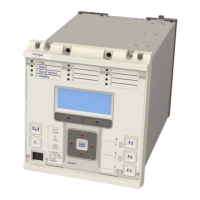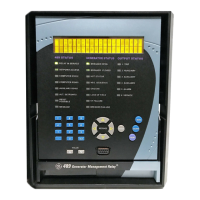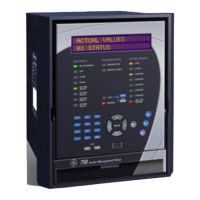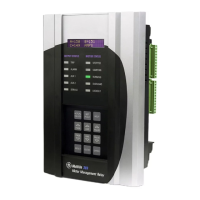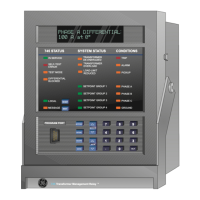Appendix B -Settings and Signals
MENU TEXT COL ROW DEFAULT SETTING AVAILABLE OPTIONS
DESCRIPTION
Normally the alarm would be raised for any loss of an operational channel (logical OR combination). However, when relays in a 3 ended
scheme are deliberately operated in Chain topology AND logic may be used, for indication when the scheme becomes finally inoperative,
with no self-healing (signal rerouting) mode possible.
Channel Timeout 20 1E 0.1
From 0.1 to 10 in steps of 0.1
[Courier Number (time-seconds)]
A rolling time window beyond which any of the 8 IM signals that are set to ‘Default’ will be replaced by the corresponding ‘IM_X Default
Value’ setting, providing that no valid message is received on that channel in the meantime. The ‘Chnl Fail Alarm’ timer will be also initiated.
If only one channel is used, each out of 16 IM signals available that is set to ‘Default’ will convert to corresponding ‘IM_X Default Value’
If a Dual redundant or 3 ended scheme is selected, each out of 8 IM signals available that is set to ‘Default’ will convert to corresponding
‘IM_X Default Value’, but only for the affected channel.
IM Msg Alarm Lvl 20 1F 25
From 0 to 100 in steps of 0.1
[Courier Number (percentage)]
Setting that is used to alarm for poor channel quality. If during a fixed 100 ms rolling window the number of invalid messages divided by the
total number of messages that should be received (based upon the ‘Baud Rate’ setting) increase above the threshold, a ‘Channel Fail Alarm’
Prop Delay Stats 20 20 Enabled
Enabled
To enable (activate) or disable (turn off) the alarms of Maximum propagation delay time
MaxCh1 PropDelay 20 21 0.015
From 0.001 to 0.05 in steps of 0.001
[Courier Number (time-seconds)]
When the protection communications are enabled, the overall propagation delay divided by 2 is calculated and the maximum value is
determined and displayed in Measurements 4 column. This value is displayed and compared against this setting. If the setting is exceeded,
an alarm MaxCh1 PropDelay (DDB 1386) is raised.
MaxCh2 PropDelay 20 22 0.015
From 0.001 to 0.05 in steps of 0.001
[Courier Number (time-seconds)]
When the protection communications are enabled, the overall propagation delay divided by 2 is calculated and the maximum value is
determined and displayed in Measurements 4 column. This value is displayed and compared against this setting. If the setting is exceeded,
an alarm MaxCh2 PropDelay (DDB 1387) is raised.
IM1 Cmd Type 20 30 Permissive
Permissive
Setting that defines the operative mode of the received InterMiCOM_1 signal.
When ‘Direct’ tripping is chosen, for security reasons 2 consecutive valid messages have to be received before a change in the signal status
will be acknowledged. That will impose an additional 1-2 ms delay comparing to ‘Permissive’ mode.
Set ‘Direct’ in Direct Transfer Tripping (Intertripping) applications.
Set ‘Permissive’ to accommodate any Permissive or Blocking scheme.
IM1 FallBackMode 20 31 Default
Latched
Setting that defines the status of IM1 signal in case of heavy noise and message synchronization being lost.
If set to Latching the last valid IM1 status will be maintained until the new valid message is received.
If set to Default, the IM1 status, pre-defined by the user in IM1 Default Value cell will be set. A new valid message will replace IM1 Default
Value, once the channel recovers.
IM1 DefaultValue 20 32 0
0 or 1
[Unsigned Integer(16 bit)]
Setting that defines the IM1 fallback status.
IM2 Cmd Type 20 34 Permissive
Permissive
[Indexed String]
Setting that defines the operative mode of the received InterMiCOM_2 signal.
When ‘Direct’ tripping is chosen, for security reasons 2 consecutive valid messages have to be received before a change in the signal status
will be acknowledged. That will impose an additional 1-2 ms delay comparing to ‘Permissive’ mode.
Set ‘Direct’ in Direct Transfer Tripping (Intertripping) applications.
Set ‘Permissive’ to accommodate any Permissive or Blocking scheme.
IM2 FallBackMode 20 35 Default
Latched
Setting that defines the status of IM2 signal in case of heavy noise and message synchronization being lost.
If set to Latching the last valid IM2 status will be maintained until the new valid message is received.
If set to Default, the IM2 status, pre-defined by the user in IM2 Default Value cell will be set. A new valid message will replace IM2 Default
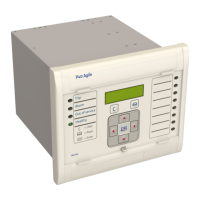
